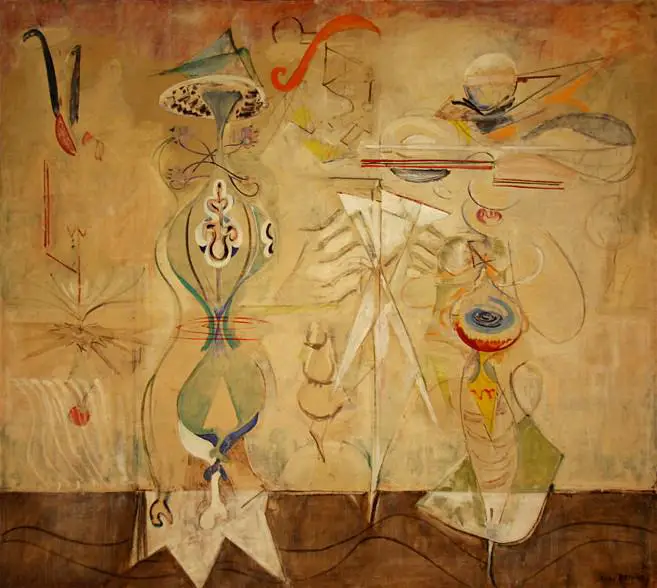Mark Rothko, along with the other members of the New York School, was greatly affected by the Surrealist movement, an influence that intensified with the influx in New York of European artists following the outbreak of World Wall II, including Andre Breton, Max Ernst, Andre Masson and Matta. The Surrealist principle of automatism lead to improvisation in the act of painting and the use of dream imagery as a way to delve into the collective unconscious. Like the Surrealists, the Americans were looking to communicate universal truths and meanings. Although Rothko never joined the Surrealist circle, many of his works of the mid-1940s contains biomorphic forms, symbols, and emblems favored by the Surrealists.
The paintings Rothko showed in his 1945 solo exhibition at Peggy Guggenheim's Art of The Century gallery in New York suggest that by this time he was less interested in the friezelike compositions of his mythic works. In Slow Swirl by the Edge of Sea, the figures have broken out of grid and move freely in a less defined space. New to the painting is a sense of transparency that would become central to his mature works. Painted during his courtship with his second wife, it is likely that Slow Swirl by the Edge of Sea represents Rothko and Mell. The work was initially acquired by the San Francisco Museum of Fine Art but was traded back to Rothko and hung in the family's East 95th Street townhouse from 1961 until Mell's death in 1970.
The gyrating, swirling figures are reminiscent of the graceful calligraphic drawings of Masson and Matta. One can also see elements of Swallow's Tail by Dali in the curled red line at the top of the painting. There is so much to see and enjoy within this composition that it still surprises many that Rothko is only known by many for his Color Field rectangles of colour, which would actually occur a few years later. Before that extreme use of abstraction, he was clearly more of an expressionist painter where genuine objects could be seen and understood. Many members related to this group would create their own visual languages that would be used over and over again, making those familiar with their careers able to link meaning from one artwork to the next. Surrealism would also see that regularly too, such as with Dali who re-used items such as clocks and certain animals many times.
Joan Miro was another painter who slowly became more abstract over time and eventually created his own visual language, in which simple shapes in single colours along with sharp lines would produce all manner of different interpretations of elements from real life. He sat on the fringes of surrealism and beared some similarities but was very much his own man. Carnival of Harlequin and Catalan Landscape offer the reduction of body parts and whole figures down into simple shapes, such as triangles and wavy lines. Previously, the objects in his work would be far more identifiable and related more to more traditional artistic influences. Besides the likes of Miro and Dali, Matisse was another key artist from the 20th century and someone who was specifically mentioned by Rothko as an inspiration, mainly in his use of colour.
Within this composition, we find an array of detail to study. There appear to be two creatures dancing amidst a rough landscape, with sky above and land below. Around them is an array of stripes and spirals which produce a magical atmosphere, which seems almost inspired by elements of marine life. The artist himself described this painting as an adventure into an unknown world, which certainly matches the observations made by us here. One does not necessarily have to identify specific elements from reality here, that may not be the intention and the creatures themselves are most likely inspired by the deepest imagination of the artist. A fairly similar approach is used by the artist in Archaic Idol, which is from the same year of 1945. It would be just a few years before he would throw himself entirely into the Color Field style that would dominate the rest of his career.
It is believed that this painting occured shortly after Rothko had divorced his first wife and was in the midst of a romantic period with the woman who would later become his wife. This early stage of any relationship can often be exciting and without the mundanity that inevitably sets in later on as reality kicks in. The two figures could therefore be the artist and his new partner, put together in the surrealist style which he was working with at the time. The colour scheme may also reflect his own positivity at the time and his instincts were clearly well placed, with their relationship continuing to flourish for many more years.

